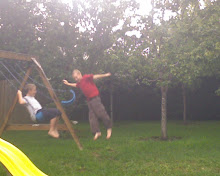You know what's fun? Wikipedia.com. I have finally realized that any little wonder I have during the day can probably be answered on this amazing website. So, you ask, what did I want to know?
I wanted to test a theory. I've wondered since about 10th grade what that & (ampersand) symbol means. Yes, it's shorter than "and", but is the symbol supposed to represent those three letters or what? This year I began learning French, and at one point, I realized that "&" is more likely is a combination, or ligature -- combined letters) of "e" and "t". I wanted to know for sure. I looked it up, and learned all about it! Ampersand. They showed the normal & and another older version which looks more like a connected E and T. And "ampersand" means "per se" is because & used to be the 27th letter of the alphabet, after Z. So, when people would say an old alphabet rhyme, they would say "x, y, z, and per se and that's the end" -- or something like that. So, the "and, per se, and..." merged together to become "ampersand". Now I'll never wonder again.
I wanted to know what was up with that long S that people say used to be an S but doesn't look at all like an S. Turns out it's called a Long S and the short version of the story is that there used to be two ways of writing an S, depending on where it fell in the word. This used to be a lot more common when everything was hand-written; part of the flourish a formal document held.
This lead to an interest in that "B"-shaped letter used in German that I also never did understand: ß. Turns out it's called an eszett, which is really just two S's next to each other: the Long S and the Short, or Round s. So, the German word strasse (street) is written straße.




No comments:
Post a Comment